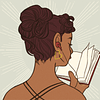Take a photo of a barcode or cover
A moving and beautiful book about a part of American history that is little known. Congo Square is a place in New Orleans where slaves were allowed to gather on Sundays. There they made music, they danced and sang. It was a place were slaves were able to make traditional African music, which was forbidden in most other places in the United States. In Congo Square slaves had a Sunday market in addition to music and dancing. It was the highlight of their week, they met, enjoyed themselves, and passed news to each other.
The pictures are beautiful. The text is powerful, lyrical, and poignant. I love everything about this book, and am so glad I bought it.
Age: Kindergarten-2nd grade
History: Slavery
Weatherford and Christie depict the days of the week for slaves and builds anticipation for Sunday, the one afternoon that slaves were allowed to commune. The artwork was unique and full of movement without being frightening. (Lately, I have seen so much unusual picture book artwork that is nightmare-inducing, so I'm glad to see that it can be done.) The author includes a forward AND an Author's Note to elaborate on the relatively sparse--yet poetic--text. A well-written introduction to the inhumanity of slavery without being graphic and still celebrating the shared cultural get-together of one afternoon.
History: Slavery
Weatherford and Christie depict the days of the week for slaves and builds anticipation for Sunday, the one afternoon that slaves were allowed to commune. The artwork was unique and full of movement without being frightening. (Lately, I have seen so much unusual picture book artwork that is nightmare-inducing, so I'm glad to see that it can be done.) The author includes a forward AND an Author's Note to elaborate on the relatively sparse--yet poetic--text. A well-written introduction to the inhumanity of slavery without being graphic and still celebrating the shared cultural get-together of one afternoon.
Freedom in Congo Square, written by Carole Boston Weatherford with illustrations by R. Gregory Christie, is a terrific book for the 4-8 age group. It depicts the infamous area in New Orleans where slaves were able to gather to worship and celebrate their collectively indomitable spirit even in the throes of their enslavement. Written in a wonderfully lyrical prose, the story captures the juxtaposition of ceaseless chores to furtive anticipation of work-free Sunday. Handsomely illustrated in a folk art style, the images evoke hardship as well as vitality. A fact-filled foreword describes many details of the history of Congo Square including musical instruments and dances brought from the native lands of captured slaves. This is a book well worth sharing with children interested in history.
A gentle tool to broach the subject of slavery with kids. I really liked the illustration style, but was lost when the countdown format ended and became something else.
emotional
informative
sad
fast-paced
I lived in Baton Rouge for 6 years, have been to New Orleans more times than I can count, and never heard of Congo Square. This was a wonderful book!
Read for our school's mock Caldecott, and deserving of its Caldecott Honor win.
Wow! I've heard a lot about this picture book because it's won both the Caldecott Honor and the Coretta Scott King Honor. This goes beyond the usual confines of a picture book. It examines the one place that slaves and free blacks were able to spend time together in New Orleans. The artwork was not only dynamic, but told in such a captivating way that I learned a lot about the history of Congo Square. While I won't delve into the historical aspects of the book, I do recommend this as a book for both children and adults to check out to learn more about this enriching part of history.






